![]()
![]()
![]()
Use LEFT and RIGHT arrow keys to navigate between flashcards;
Use UP and DOWN arrow keys to flip the card;
H to show hint;
A reads text to speech;
141 Cards in this Set
- Front
- Back
|
Describe where exactly the thoracic inlet lies:
|
The thoracic inlet is the region of the upper thorax marginated by the first rib and represents the junction between the neck and thorax.
|
|
|
List some causes of thoracic inlet masses:
|
Thyroid mass
-Goiter -Malignancy -Thyromegaly resulting from thyroiditis Parathyroid mass -Hyperplasia -Adenoma -Carcinoma Lymph node mass -Lymphoma -Metastases Inflammatory -Tuberculosis Lymphangioma |
|
|
What do thyroid masses look like on CXR?
|
-An anterosuperior mediastinal mass typically deviates the trachea laterally and either posteriorly (anterior masses) or anteriorly (posterior masses).
-Coarse, clumped calcifications are common in thyroid goiters. |
|
|
What do thyroid masses look like on CT?
|
CT usually shows characteristic findings:
(1) well-defined margins, (2) continuity of the mass with the cervical thyroid (3) coarse calcifications, (4) cystic or necrotic areas (5) baseline high CT attenuation (because of intrinsic iodine content) (6) intense enhancement (>25 H) as a result of the hypervascularity of most thyroid masses and prolonged enhancement (resulting from active uptake of iodine from contrast media) following intravenous contrast administration |
|
|
Why would a parathyroid gland be found in the thoracic inlet?
|
-In approximately 2% of patients, the parathyroid glands fail to separate from the thymus in the neck and descend with the gland into the anterosuperior mediastinum.
-These glands can be found near the thoracic inlet in or about the thymus. |
|
|
Describe a lymphangioma. What are they associated with?
|
-These uncommon masses are tumors comprised of dilated lymphatic channels.
-The cystic or cavernous form (cystic hygroma) is most commonly discovered in infancy and is often associated with chromosomal abnormalities, including Turner syndrome and trisomies 13, 18, and 21. -Histologically, these tumors are composed of cystic spaces lined by epithelium and contain clear, straw-colored fluid. -Although these lesions are benign histologically, they tend to insinuate themselves between vascular structures and the trachea. This makes complete surgical resection of lymphangiomas difficult, and they frequently recur. |
|
|
Where are cystic/cavernous hygromas located?
|
In infants, these lesions tend to extend from the neck into the anterior mediastinum; less commonly they may arise primarily within the anterior mediastinum in older patients.
|
|
|
CT/MR appearance of cystic hygromas?
|
CT demonstrates a well-defined cystic mass within the thoracic inlet or superior mediastinum. MR typically shows a mass of high signal intensity on T2WIs because of the fluid content.
|
|
|
What syndromes are thymomas associated with?
|
While most often associated with myasthenia gravis, thymoma has been associated with other autoimmune diseases, such as pure red cell aplasia, Graves disease, Sjögren syndrome, and hypogammaglobulinemia.
|
|
|
What percent of myasthenia gravis pts have a thymoma?
|
Of patients with myasthenia gravis, 10% to 28% have a thymoma, while a larger percentage of patients with thymoma (30% to 54%) have or will develop myasthenia.
|
|
|
What do thymomas look like on chest x-ray?
|
On chest radiographs, thymomas are seen as round or oval, smooth or lobulated soft tissue masses arising near the origin of the great vessels at the base of the heart
|
|
|
What do thymomas look like on CT? Can imaging tell the difference between a benign thymoma and a malignant thymic carcinoma? How do they tend to spread?
|
-As a result of their firm consistency, thymomas characteristically maintain their shape where they contact the sternum anteriorly and heart and great vessels posteriorly.
-Compared to type A tumors, higher-grade thymomas, particularly types B3 and C, tend to show larger size, more irregular margins, heterogeneous enhancement, regions of necrosis, mediastinal nodal metastases, and calcification. -Invasion of tumor through the thymic capsule may be impossible to tell by CT or MR and may even be difficult to determine on examination of the resected specimen. -Local invasion of pleura, lung, pericardium, chest wall, diaphragm, and great vessels occurs, but contiguity of a thymoma with the adjacent chest wall or mediastinal structures cannot be used as reliable evidence of invasion of these structures. -Drop metastases to dependent portions of the pleural space are a recognized route of spread of thymoma that has invaded the pleura. -Extrathoracic metastases are rare, although transdiaphragmatic spread of a pleural tumor into the retroperitoneum has been described. |
|
|
What causes thymic cysts?
|
-Congenital unilocular thymic cysts are rare lesions that represent remnants of the thymopharyngeal duct and contain thin or gelatinous fluid.
-Acquired multilocular thymic cysts are postinflammatory in nature and have been associated with AIDS, prior radiation or surgery, and autoimmune conditions such as Sjögren syndrome, myasthenia gravis, and aplastic anemia; in these latter conditions, clinical and radiologic distinction of multilocular thymic cyst from thymoma may be difficult |
|
|
List causes of anterior mediastinal masses:
|
Thymic masses
-Thymoma -Thymic cyst -Thymolipoma -Thymic hyperplasia -Thymic neuroendocrine tumors -Thymic carcinoma -Thymic lymphoma "Terrible" Lymphoma -Hodgkin -Non-Hodgkin Germ cell neoplasms -Teratoma (benign or malignant) -Seminoma -Embryonal cell carcinoma -Endodermal sinus tumor -Choriocarcinoma Thyroid mass -Goiter -Thyroid adenoma -Thyroid carcinoma -Thyroiditis Ectopic parathyroid mass -Hyperplasia -Adenoma -Carcinoma Mesenchymal tumor -Lipoma -Hemangioma -Leiomyoma -Liposarcoma -Angiosarcoma |
|
|
What is a thymolipoma? What does it look like?
|
Thymolipoma is a rare, benign thymic neoplasm that consists primarily of fat with intermixed rests of normal thymic tissue. These masses are asymptomatic and therefore are typically large when first detected. Chest radiographs show a large anterior mediastinal mass that, because of its pliable nature, tends to envelope the heart and diaphragm. CT demonstrates a fatty mass with interspersed soft tissue densities. Resection is curative.
|
|
|
What's the name of the thymic tumor that has a lot of fat in it and envelopes the medistinal structures?
|
Thymolipoma
|
|
|
What is an APUD tumor? What is an APUD tumor of the thymus?
|
-APUD=amine precursor uptake and decarboxylation cells
-They are neuroendocrine tumors believed to arise from cells of neural crest origin -The most common histologic type is carcinoid tumor, which, as with similar lesions arising within the bronchi, ranges in differentiation and behavior from typical carcinoid to atypical carcinoid to small cell carcinoma. |
|
|
Why do APUD tumors (thymic carcinoid) of the thymus present earlier than other thymic tumors?
|
-Approximately 40% of patients have Cushing syndrome as a result of adrenocorticotropic hormone secretion by the tumor; these patients tend to have smaller lesions at time of diagnosis since they present early with signs of corticosteroid excess.
-Carcinoid syndrome is uncommon. |
|
|
Which imaging features suggests APUD tumor of the thymus?
|
This lesion is indistinguishable from thymoma on plain radiographs and CT scans
(round or oval, smooth or lobulated soft tissue masses arising near the origin of the great vessels at the base of the heart , firm consistency so they characteristically maintain their shape where they contact the sternum anteriorly and heart and great vessels posteriorly) |
|
|
What sorts of things cause rebound thymic hyperplasia?
|
-This rare entity occurs primarily in children as a rebound effect in response to an antecedent stress, discontinuation of chemotherapy, or treatment of hypercortisolism.
-An association with Graves disease has also been noted |
|
|
What should you suggest if you think a patient has rebound thymic hyperplasia?
|
-Follow-up chest x-rays
-Occasionally thymic hyperplasia will present as a mass that is radiographically indistinguishable from thymoma, but most cases can be resolved by noting a decrease in size on follow-up studies, thereby obviating the need for biopsy. |
|
|
How does chemo typically affect the thymus gland?
|
It shrinks it
|
|
|
What type of Hodgkin's disease likes to involve the thymus? What does it look like?
|
-The thymus is involved in 40% to 50% of patients with the nodular sclerosing subtype of Hodgkin disease.
-Its radiographic appearance is indistinguishable from that of other solid neoplasms arising within the thymus. -The presence of lymph node enlargement in other portions of the mediastinum or anterior chest wall involvement should suggest the diagnosis. |
|
|
What is the most common primary mediastinal neoplasm in adults?
|
Lymphoma—either Hodgkin disease or non-Hodgkin lymphoma (NHL)—is the most common primary mediastinal neoplasm in adults.
|
|
|
What if you're considering lymphoma in a pt with hilar/mediastinal LAD, but you don't see involvement of the anterior mediastinum?
|
-The majority (90%) of patients with intrathoracic involvement have mediastinal lymph node enlargement; this most commonly involves the anterior mediastinal and hilar nodal groups.
-Isolated enlargement of mediastinal or hilar nodes outside the anterior mediastinum should suggest an alternative diagnosis. |
|
|
What should you think of if you see enlargement of the juxtaphrenic and posterior mediastinal nodes?
|
juxtaphrenic and posterior mediastinal nodal involvement is uncommon but is seen almost exclusively in NHL
|
|
|
Plain films findings suggestive of lymphoma?
|
-On conventional radiographs, lymphoma involving the anterior mediastinum is indistinguishable from thymoma or germ cell neoplasm and presents as a lobulated mass projecting to one or both sides.
-Calcification in untreated lymphoma is extremely uncommon, and its presence within an anterior mediastinal mass should suggest another diagnosis. -Involvement of other lymph nodes in the mediastinum or hila makes lymphoma more likely. -An enlarged spleen displacing the gastric air bubble medially, seen in the upper abdominal portion of the frontal chest film, provides an additional clue to the diagnosis. |
|
|
What would cause nodal calcification?
|
Prior treatment with radiation
|
|
|
What does lymph node involvement with lymphoma look like?
|
-Most commonly, discrete enlarged solid lymph nodes or conglomerate masses of nodes are seen.
-Central necrosis, seen in 20% of patients, has no prognostic significance. -Nodal calcification is rare in the absence of previous mediastinal radiation or systemic chemotherapy. |
|
|
What does untreated Hodgkin's disease look like on MR?
|
-On MR, untreated lymphoma appears as a mass of uniform low signal intensity on T1WIs and uniform high signal intensity or intermixed areas of low and high signal intensity on T2WIs.
-The areas of low signal intensity on T2WIs of untreated patients may be a result of foci of fibrotic tissue in nodular sclerosing Hodgkin disease. |
|
|
How is lymphoma treatment response determined?
|
-CT, MR, gallium scintigraphy, and fluorodeoxyglucose (FDG) PET have been used to monitor the response of lymphoma to therapy.
-While CT can accurately assess tumor regression and detect relapse within nodal groups outside the treated region, the ability to distinguish residual tumor from sterilized fibrotic masses is limited. -PET is clearly superior to CT or MR in distinguishing recurrent tumor from fibrosis in both Hodgkin disease and NHL |
|
|
What finding on MR would suggest disease recurrence in lymphoma?
|
In general, the appearance of high-signal-intensity regions on T2WIs more than 6 months after treatment should suggest recurrence.
|
|
|
Name the germ cell tumors:
|
-Teratoma
-Seminoma -Choriocarcinoma -Endodermal sinus tumor -Embryonal cell carcinoma |
|
|
What cells do anterior mediastinal germ cell tumors arise from?
|
They arise from collections of primitive germ cells that arrest in the anterior mediastinum on their journey to the gonads during embryologic development.
|
|
|
What do you have to exclude before you can diagnose a primary anterior mediastinum germ cell tumor?
|
Since they are histologically indistinguishable from germ cell tumors arising in the testes and ovaries, the diagnosis of a primary malignant mediastinal germ cell neoplasm requires exclusion of a primary gonadal tumor as a source of mediastinal metastases. A key in distinguishing primary from metastatic mediastinal germ cell neoplasm is the presence of retroperitoneal lymph node involvement in metastatic gonadal tumors.
|
|
|
How can you tell if a germ cell tumor in the anterior mediastinum is a primary versus a met from a gonasal germ cell tumor?
|
A key in distinguishing primary from metastatic mediastinal germ cell neoplasm is the presence of retroperitoneal lymph node involvement in metastatic gonadal tumors.
|
|
|
Most common mediastinal germ cell tumor?
|
The most common benign mediastinal germ cell neoplasm is teratoma, comprising 60% to 70% of mediastinal germ cell neoplasms
|
|
|
What's the difference between a solid and cystic teratoma? What's the most common? What's the gender distribution?
|
-Teratomas may be cystic or solid.
-Cystic or mature teratoma is the most common type of teratoma seen in the mediastinum. -In contrast to a dermoid cyst, which is an ovarian neoplasm containing only elements derived from the ectodermal germinal layer, a cystic teratoma of the mediastinum commonly contains tissues of ectodermal, mesodermal, and endodermal origins. -For this reason, it is inaccurate to use the term “dermoid cyst” to describe cystic mediastinal germ cell neoplasms. -Solid teratomas are usually malignant. -While benign tumors have a slight female preponderance (female/male, 60%/40%), malignant tumors are seen almost exclusively in men. |
|
|
What do benign mediastinal teratomas look like on CT?
|
On CT, benign teratomas are usually cystic and may contain soft tissue, bone, teeth, fat, or, rarely, fat–fluid levels.
|
|
|
What do malignant mediastinal teratomas look like on CT?
|
-CT typically shows a large lobulated soft tissue mass that may contain areas of hemorrhage, calcification, or necrosis.
-CT evidence of gynecomastia is an additional clue. |
|
|
What lab tests are abnormal in malignant mediastinal germ cell tumors?
|
Elevated serum levels of α-fetoprotein or human chorionic gonadotropin are helpful in the diagnosis of suspected malignant mediastinal germ cell neoplasm
|
|
|
How do you recognize a mediastinal lipoma?
|
-Lipomas can occur in any location in the mediastinum but are most often anterior.
-The diagnosis is made by recognition of a well-defined mass of uniform fatty attenuation (under -50 H). -The presence of soft tissue elements should raise the possibility of a thymolipoma or liposarcoma; the latter may show evidence of invasion of adjacent structures at the time of diagnosis. |
|
|
What's the big clue that the patient has a mediastinal hemangioma?
|
A pathognomonic sign on chest radiographs is the recognition of phleboliths within a smooth or lobulated soft tissue mass.
|
|
|
What's the diagnosis if you phleboliths in the mediastinum?
|
Mediastinal hemangioma
|
|
|
Imaging features of enlarged mediastinal lymph nodes?
|
-The presence of multiple bilateral mediastinal masses that distort the lung/mediastinal interface is relatively specific for lymph node enlargement.
-Solitary masses resulting from lymph node enlargement tend to be elongated and lobulated rather than spherical, since usually more than a single node in a vertical chain of nodes is involved. -Occasionally, calcification can be detected within enlarged lymph nodes on plain radiographs; CT is more sensitive in detecting nodal calcification and its distribution within lymph nodes. |
|
|
List some benign causes of mediastinal lymph node enlargement:
|
-Sarcoidosis
-Mycobacterial and fungal infection -Angiofollicular lymph node hyperplasia (Castleman disease) -Angioimmunoblastic lymphadenopathy. |
|
|
Alrighty, give a differential for middle mediastinal masses:
|
Lymph node masses:
-Malignant: Lymphoma Mets -Benign: Reactive (from viral, fungal, or bacterial infections) Sarcoidosis Castleman disease Angioimmunoblastic lymphadenopathy Foregut and mesothelial cysts: Bronchogenic cyst Pericardial cyst Tracheal and central bronchial neoplasms: Carcinoid tumor (bronchi) Adenoid cystic carcinoma (trachea) Squamous cell carcinoma Diaphragmatic hernias Foramen of Morgagni hernia Traumatic hernia Vascular lesions: -Arterial: Double arch/right arch Tortuous innominate/subclavian artery Aneurysm of the aortic arch -Venous: Dilated azygos vein Dilated hemiazygos vein Dilated SVC Left-sided SVC Dilated left superior intercostal vein Dilatation of the main pulmonary artery |
|
|
What is the cutoff for normal mediastinal lymph node diameter?
|
In general, abnormal lymph nodes are seen as round or oval soft tissue masses that measure >1.0 cm in their short axis diameter.
|
|
|
What dx do centrally calcified mediastinal/hilar lymph nodes suggest? What about peripherally calcified nodes?
|
Central calcifications:
Mycobacteria Fungus Peripheral (eggshell): Silicosis Sarcoidosis |
|
|
What dx's should you think of if you see hypervascular enlarged mediastinal/hilar lymph nodes?
|
-Carcinoid tumor/small cell carcinoma
-Kaposi sarcoma -Metastases: Renal cell carcinoma Thyroid carcinoma -Castleman disease |
|
|
What dx's should you think of if you see necrotic mediastinal/hilar lymph nodes?
|
-Mycobacteria
-Fungus -Metastases: Squamous cell carcinoma Seminoma -Lymphoma |
|
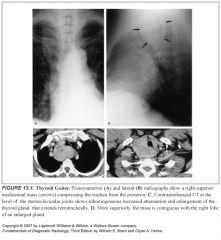
|
1
|
|
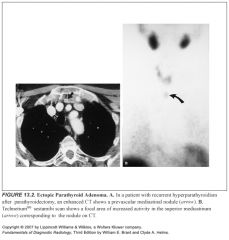
|
2
|
|
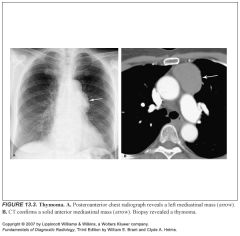
|
3
|
|
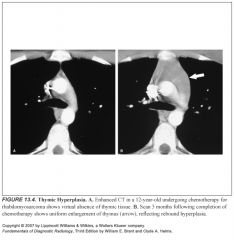
|
4
|
|
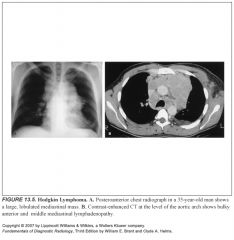
|
5
|
|
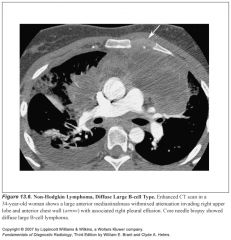
|
6
|
|
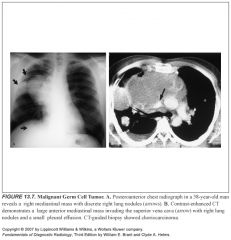
|
7
|
|
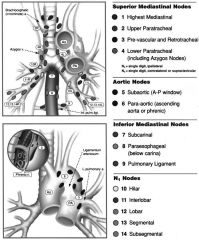
|
8
|
|
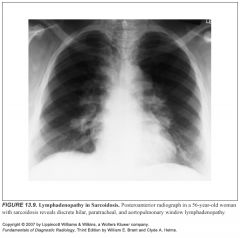
|
9
|
|
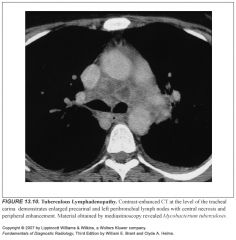
|
10
|
|
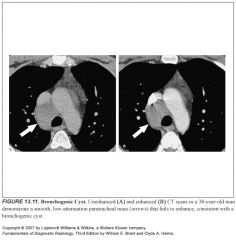
|
11
|
|
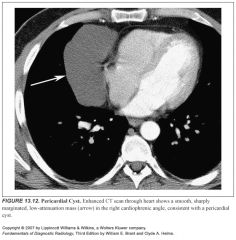
|
12
|
|
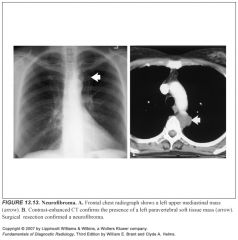
|
13
|
|
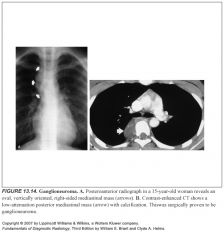
|
14
|
|
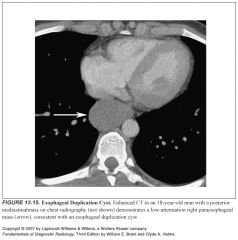
|
15
|
|
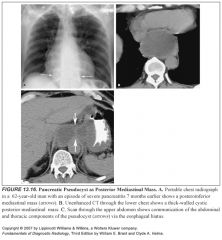
|
16
|
|
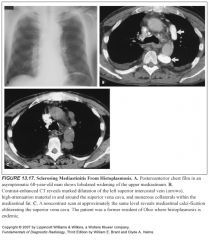
|
17
|
|
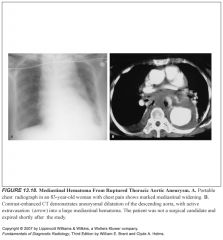
|
18
|
|
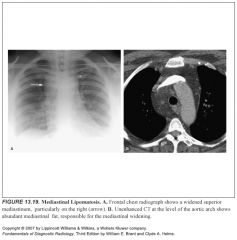
|
19
|
|
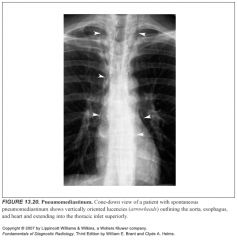
|
20
|
|
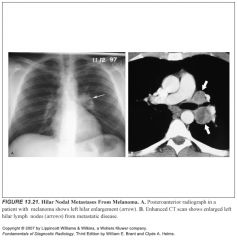
|
21
|
|
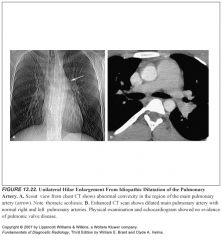
|
22
|
|
|
Which type of lung cancer can present as mediastinal lymphadenopathy without a conspicuous pulmonary nodule?
|
small cell carcinoma
|
|
|
How can you tell lymphadenopathy from sarcoidosis apart from metastatic disease or lymphoma?
|
-Nodal enlargement in sarcoidosis is typically bilateral and symmetric and involves the hila as well as the mediastinum; this usually allows for differentiation of sarcoidosis from lymphoma and metastatic disease.
-In sarcoidosis, the enlarged nodes produce a lobulated appearance on chest radiographs and CT, because the enlarged nodes do not coalesce. -This is in contrast to lymphoma and nodal metastases, in which the intranodal tumor extends through the nodal capsule to form conglomerate enlarged nodal masses. |
|
|
Which infections tend to cause mediastinal lymphadenopathy?
|
-A variety of infections, most commonly histoplasmosis, coccidioidomycosis, cryptococcosis, and tuberculosis, can cause mediastinal nodal enlargement
-Bacterial infections such as anthrax, bubonic plague, and tularemia are uncommon causes of lymph node enlargement. -Bacterial lung abscesses also may be associated with reactive lymph node enlargement. -Hilar and mediastinal lymph nodes may be enlarged in patients with measles pneumonia and infectious mononucleosis. |
|
|
What is Castleman's disease?
|
Angiofollicular lymph node hyperplasia (Castleman disease) is characterized by enlargement of hilar and mediastinal lymph nodes, predominantly in the middle and posterior mediastinal compartments. In the more common hyaline vascular type, the disease is localized to one lymph node region and presents as an asymptomatic mediastinal soft tissue mass.
-The vascular nature of these masses accounts for the intense enhancement seen on contrast-enhanced CT or angiography. -Calcification within these masses has been described. -These lesions are cured by resection. |
|
|
What disease looks just like Castleman's disease?
|
Angioimmunoblastic lymphadenopathy
|
|
|
What's the weird disease that's like AIDS for elderly patients?
|
Angioimmunoblastic lymphadenopathy
|
|
|
What is angioimmunoblastic lymphadenopathy? What does it look like?
|
-Angioimmunoblastic lymphadenopathy is a rare disorder seen in older adults; it is characterized by constitutional symptoms, lymphadenopathy, hepatosplenomegaly, and skin rash.
-Hemolytic anemia and hypergammaglobulinemia may be seen. -Chest radiographs and CT show hilar and mediastinal lymph node enlargement that are indistinguishable from other etiologies. -As with Castleman disease, the vascular nature of the involved lymph nodes accounts for the contrast enhancement seen on CT. -These patients manifest signs of immunodeficiency similar to those associated with AIDS, with one third developing high-grade lymphoma and many succumbing to opportunistic infections such as Pneumocystis carinii pneumonia and cytomegalovirus inclusion disease. |
|
|
How can you tell the difference between a bronchogenic cyst and an enteric cyst?
|
-It is often difficult to distinguish between bronchogenic and enteric cysts based on their location and pathologic appearance
-The term foregut cyst has been used to describe those lesions that cannot be specifically characterized. |
|
|
What do bronchogenic cysts look like on CXR and CT?
|
-The majority of bronchogenic cysts (80% to 90%) arise within the mediastinum in the vicinity of the tracheal carina.
-Bronchogenic cysts are seen as soft tissue masses in the subcarinal or right paratracheal space on frontal chest radiographs; less common sites of involvement include the hilum, posterior mediastinum, and periesophageal region. -They appear as a single smooth, round, or elliptic mass; a minority are lobulated in contour. -CT is the method of choice for the diagnosis of a mediastinal cyst. -If a well-defined, thin-walled mass of fluid density (0 to 10 H) is seen that fails to enhance following intravenous contrast administration, it can be assumed to represent a benign cyst. -High CT numbers (>40 H) suggesting a solid mass can be seen when the cyst is filled with mucoid material, milk of calcium, or blood. -Calcification of the cyst wall has been described but is uncommon. |
|
|
Symptoms of a bronchogenic cyst?
|
-Most mediastinal lesions are asymptomatic; occasionally, compression of the tracheobronchial tree or esophagus may produce dyspnea, wheezing, or dysphagia.
-Rarely, mediastinal cysts become secondarily infected after communication with the airway or esophagus, or they cause symptomatic compression after rapid enlargement following hemorrhage. |
|
|
What do bronchogenic cysts look like on MR?
|
-MR shows characteristic low signal intensity on T1WIs and high signal intensity on T2WIs.
-The presence of proteinaceous material within the cyst will shorten T1 relaxation times, yielding high signal intensity on T1WIs. |
|
|
What are pericardial cysts? What do they look like on imaging?
|
-Pericardial cysts arise from the parietal pericardium and contain clear serous fluid surrounded by a layer of mesothelial cells.
-Most often, they arise in the anterior cardiophrenic angles, with right-sided lesions being twice as common as left-sided lesions; approximately 20% arise more superiorly within the mediastinum. -These lesions usually present as incidental asymptomatic round or oval masses in the cardiophrenic angle -Their pliable nature can be demonstrated with a change in patient position. -CT typically shows a unilocular cystic mass adjacent to the heart -MR or US via a subxiphoid approach shows findings characteristic of a simple cyst. -As with bronchogenic cysts, there have been reports of cysts with high attenuation on CT that on resection are found to be filled with proteinaceous or mucoid material. |
|
|
When would a neurofibroma present as a middle mediastinal mass?
|
Rarely, a neurofibroma arising from the phrenic nerve may present as a middle mediastinal juxtacardiac mass.
|
|
|
What are the different types of neurogenic tumors?
|
Three groups have been recognized:
(1) tumors arising from intercostal nerves (neurofibroma, schwannoma); (2) sympathetic ganglia (ganglioneuroma, ganglioneuroblastoma, and neuroblastoma) (3) paraganglionic cells (chemodectoma, pheochromocytoma). -Tumors in each of these three groups may be benign or malignant neoplasms |
|
|
What does neurogenic tumors of the chest look like?
|
-Radiographically, intercostal nerve tumors appear as round or oval paravertebral soft tissue masses.
-CT shows a smooth or lobulated paraspinal soft tissue mass, which may erode the adjacent vertebral body or rib. -CT demonstration of tumor extension from the paravertebral space into the spinal canal via an enlarged intervertebral foramen is characteristic of a “dumbbell” neurofibroma. -MR is the modality of choice for imaging a suspected neurofibroma. -In addition to the occasional demonstration of both intra–and extra–spinal canal components, MR of neurofibromas shows typical high signal intensity on T2WIs. |
|
|
Differential for a posterior mediastinal mass?
|
Neurogenic tumors
-Peripheral (intercostal) nerves (Neurofibroma, Schwannoma) -Sympathetic ganglia (Ganglioneuroma, Ganglioneuroblastoma, Neuroblastoma) -Paraganglion cells (Chemodectoma, Pheochromocytoma) Esophageal lesions -Duplication (enteric) cyst -Diverticulum -Neoplasm (Leiomyoma, squamous cell carcinoma) -Esophageal dilatation (Achalasia, Scleroderma, Peptic stricture, Carcinoma) -Paraesophageal varices -Hiatal hernia (Sliding, Paraesophageal) -Foregut cysts (Enteric Neurenteric) Vertebral lesion -Trauma (Paraspinal hematoma) -Infection (Paraspinal abscess, Tuberculosis) -Tumor (Metastases (bronchogenic, breast, renal cell carcinoma), Multiple myeloma, Lymphoma -Degenerative disease (osteophytosis) -Extramedullary hematopoiesis -Lateral thoracic meningocele Pancreatic pseudocyst |
|
|
What could you use to tell a sympathetic ganglion mass (neuroblastoma, ganglioneuroma) apart from a neurofibroma?
|
-Sympathetic ganglion tumors generally present as elongated, vertically oriented paravertebral soft tissue masses with a broad area of contact with the posterior mediastinum.
-These findings may help distinguish these lesions from neurofibromas, which usually maintain an acute angle with the vertebral column and posterior mediastinum and therefore tend to show sharp superior and inferior margins on lateral chest radiographs. |
|
|
What do sympathetic ganglion masses (neuroblastoma, ganglioneuroma) look like? What should the lab values show?
|
-Sympathetic ganglion tumors generally present as elongated, vertically oriented paravertebral soft tissue masses with a broad area of contact with the posterior mediastinum.
-Large masses may erode vertebral bodies or ribs. -Calcification, seen in up to 25% of cases, is a helpful diagnostic feature of these tumors but does not help distinguish benign from malignant neoplasms. -Because these tumors often produce catecholamines, urinary levels of vanillylmandelic acid or metanephrines, which are byproducts of catecholamine metabolism, may be elevated |
|
|
What is a chemodectoma?
|
-A non-functioning tumor of the sympathetic chain
-They occur almost exclusively in or about the aortopulmonary window |
|
|
When pheochromocytomas occur in the mediastinum, where are they located?
|
-They are found in the posterior sympathetic chain or in or about the heart or pericardium.
-Approximately 2% of all pheochromocytomas arise in the mediastinum. |
|
|
What nucs scan is used to see functioning tumors of the sympathetic chain?
|
Radionuclide iodine-131-meta-iodobenzylguanidine (MIBG) scanning is diagnostic in functioning tumors.
|
|
|
Manifestations of esophageal cancer on chest x-rays?
|
Most patients with esophageal carcinoma have abnormal plain radiographic findings, including an abnormal azygoesophageal interface, widening of the mediastinum (resulting from the tumor itself or a dilated esophagus proximal to the obstructing lesion), abnormal thickening of the tracheoesophageal stripe, and tracheal deviation and compression.
|
|
|
Manifestations of esophageal cancer on chest CT?
|
CT scanning has proved accurate for staging esophageal carcinoma: findings include an intraluminal mass; thickening of the esophageal wall; loss of fat planes between the esophagus and adjacent mediastinal structures (usually the trachea, with upper esophageal lesions, and the descending aorta, with lower esophageal lesions); and evidence of nodal and distant metastases.
|
|
|
What do benign esophageal tumors look like on chest xray and CT? How can you tell benign from malignant masses?
|
-Several benign esophageal neoplasms, including leiomyoma, fibroma, and lipoma, can present as smooth, solitary mediastinal masses projecting laterally from the posterior mediastinum on frontal chest radiographs.
-They generally involve the lower third of the esophagus from the level of the subcarinal space to the esophageal hiatus. -CT demonstrates a smooth, well-defined soft tissue mass adjacent to the esophagus without obstruction. -The absence of esophageal dilatation above the mass helps distinguish benign tumors from carcinoma. |
|
|
What do esophageal diverticula look like on chest x-rays?
|
-A large proximal pulsion diverticulum (Zenker) may extend through the thoracic inlet and appear as a retroesophageal superior mediastinal mass containing an air–fluid level on upright chest radiographs.
-A distal pulsion diverticulum appears as a juxtadiaphragmatic mass with an air–fluid level projecting to the right of midline. |
|
|
What does a dilated esophagus look like on chest x-ray?
|
-A dilated esophagus resulting from functional (achalasia, scleroderma) or anatomic (stricture, carcinoma) obstruction may produce a mass that courses vertically over the length of the mediastinum, projecting toward the right side on frontal chest radiographs.
-An air–fluid level on upright films is usually present. -A completely air-filled, dilated esophagus appears as a thin curvilinear line along the medial right thorax, because the right lateral wall of the esophagus is outlined by intraluminal air medially and the right lung laterally. |
|
|
How would esophageal varices present on chest x-ray?
|
Esophageal varices may produce a round or lobulated retrocardiac mass in patients with portal hypertension.
|
|
|
How does a hiatal hernia present on chest x-ray?
What sorts of things are contained within a hiatal hernia? |
-A common cause of a mass in the posteroinferior mediastinum is a hiatal hernia.
-The characteristic location at the esophageal hiatus and the presence of a rounded density containing an air or air–fluid level on upright films are diagnostic. -The stomach is by far the most common structure in the hernia sac; the gastric cardia (sliding hernia) or fundus (paraesophageal hernia) may be involved. -Rarely, omental fat, ascitic fluid, or a pancreatic pseudocyst herniates through the esophageal hiatus into the mediastinum. |
|
|
What's the difference between an enteric cyst and a neurenteric cyst?
|
-Enteric cysts are fluid-filled masses lined by enteric epithelium.
-Esophageal cysts usually arise intramurally or immediately adjacent to the esophagus. -When an enteric cyst has a persistent communication with the spinal canal (canal of Kovalevski) and is associated with congenital defects of the thoracic spine (anterior spina bifida, hemivertebrae, or butterfly vertebrae), it is termed a neurenteric cyst. |
|
|
Describe the mechanisms by which neoplastric, infectious, metabolic, traumatic, or degenerative processes of the thoracic spine might produce a paraspinal mass:
|
Neoplastic, infectious, metabolic, traumatic, or degenerative processes of the thoracic spine may produce a paraspinal mass by one of four mechanisms:
(1) expansion of vertebral body or posterior elements (multiple myeloma, aneurysmal bone cyst) (2) extraosseous extension of infection, tumor, or marrow elements (infectious spondylitis, metastatic carcinoma, extramedullary hematopoiesis, respectively); (3) pathologic fracture and paraspinal hematoma formation (any destructive neoplastic or inflammatory process, trauma) (4) protrusion of degenerative osteophytes. |
|
|
What conditions cause extramedullary hematopoiesis?
What does it look like on imaging? |
-Extramedullary hematopoiesis is seen almost exclusively in conditions associated with ineffective production or excessive destruction of erythrocytes, such as thalassemia major, congenital spherocytosis, and sickle cell anemia.
-It is recognized by noting expansion of the medullary space and cyst formation within long bones, ribs, and vertebral bodies, with associated lobulated paraspinal soft tissue masses. -These masses, which represent hyperplastic bone marrow that has extruded from the vertebral bodies and posterior ribs, are typically seen in the lower thoracic and upper lumbar region. |
|
|
Which side of the thoracic spine tends to have more prominent osteophytes? Why?
|
Osteophytes are most commonly right-sided because of the inhibitory effect of the pulsating descending aorta on left-sided osteophyte formation.
|
|
|
What is a lateral thoracic meningocele?
On which side are they more common? Which condition are they associated with? |
-Lateral thoracic meningoceles represent an anomalous herniation of the spinal meninges through an intervertebral foramen, resulting in a paravertebral soft tissue mass.
-Most meningoceles are discovered in middle-aged patients as asymptomatic masses. -They are slightly more common on the right, and are multiple in 10% of cases. -There is a high association between lateral thoracic meningoceles and neurofibromatosis. |
|
|
What is is the most common posterior mediastinal mass in patients with neurofibromatosis?
|
A meningocele is the most common posterior mediastinal mass in patients with neurofibromatosis; conversely, approximately two thirds of patients with meningoceles have neurofibromatosis.
|
|
|
What does a lateral thoracic meningocele look like on imaging?
|
-Chest radiographs typically reveal a round, well-defined paraspinal mass that is indistinguishable from a neurofibroma.
-Additional clues to the diagnosis include rib erosion, enlargement of the adjacent neural foramen, vertebral anomalies, or kyphoscoliosis. -When a lateral meningocele is associated with kyphoscoliosis, it is usually found at the apex of the scoliotic curve on the convex side. -MR demonstration of a herniated subarachnoid space is the diagnostic technique of choice; conventional or CT myelography, which demonstrates filling of the meningocele with contrast, is reserved for equivocal cases. |
|
|
Describe how a pancreatic pseudocyst might produce a mediastinal mass:
|
-A pancreatic pseudocyst rarely produces a posterior mediastinal mass by extending cephalad from the retroperitoneum through the esophageal or aortic hiatus of the diaphragm.
-The diagnosis relies on CT demonstration of continuity of a predominantly cystic mass with its retroperitoneal portion. -The presence of a left pleural effusion is a further clue to the diagnosis. |
|
|
What is your differential for smooth mediastinal widening?
What about lobulated mediastinal widening? |
Smooth:
-Mediastinal lipomatosis -Malignant infiltration Lymphoma Small cell carcinoma Adenocarcinoma -Mediastinal hemorrhage Arterial bleeding Traumatic aortic arch/great vessel laceration Aneurysmal rupture Venous bleeding SVC/right atrial laceration -Mediastinitis Acute (suppurative) Chronic (sclerosing) Histoplasmosis Tuberculosis Idiopathic Lobulated: -Lymph node enlargement -Thymic mass -Germ cell neoplasm -Vascular lesions Tortuosity of great vessels SVC occlusion (dilated venous collaterals) Malignancy Sclerosing mediastinitis Catheter-induced thrombosis -Neurofibromatosis |
|
|
What are the most common causes of acute mediastinitis?
|
Acute mediastinitis is caused by bacterial infection that most often develops following esophageal perforation or is a complication of cardiothoracic surgery.
-Less commonly, acute mediastinitis may develop from intramediastinal extension of infection in the neck, retropharyngeal space, lungs, pleural space, pericardium, or spine. |
|
|
What is the eponym for vomiting-induced esophageal rupture?
Where does the esophagus usually tear? What does Boerhaave syndrome look like on chest x-ray? |
-Spontaneous esophageal perforation following prolonged vomiting is termed Boerhaave syndrome.
-In this condition, a vertical tear occurs along the left posterolateral wall of the distal esophagus, just above the esophagogastric junction, leading to signs and symptoms of acute mediastinitis -The most common chest radiographic findings are widening of the superior mediastinum in 66% of patients and pleural effusion in 50% of patients. -Specific findings such as mediastinal air or air–fluid levels are less common. -When mediastinitis occurs in association with Boerhaave syndrome, pneumoperitoneum and left hydropneumothorax may be seen. |
|
|
How does acute mediastinitis present?
What does it look like on chest x-ray? |
-The clinical presentation of acute mediastinitis is usually dramatic and is characterized by severe retrosternal chest pain, fever, chills, and dysphagia, often accompanied by evidence of septic shock.
-Physical examination may reveal findings associated with pneumomediastinum, with subcutaneous emphysema in the neck and an apical, systolic crunching sound on chest auscultation (Hamman sign). -The most common chest radiographic findings are widening of the superior mediastinum in 66% of patients and pleural effusion in 50% of patients. -Specific findings such as mediastinal air or air–fluid levels are less common. -When mediastinitis occurs in association with Boerhaave syndrome, pneumoperitoneum and left hydropneumothorax may be seen. |
|
|
What imaging should be performed when esophageal perforation is suspected?
What contrast should be used? |
-When esophageal perforation is suspected, an esophagram should be performed to detect leakage of contrast into the mediastinum and to localize the exact site of perforation.
-In a patient not at risk for aspiration, a water-soluble contrast agent is administered initially. -Once gross contrast extravasation has been excluded, barium is then given for superior radiographic detail. -The sensitivity of the esophagram for detecting contrast leakage is highest when the study is obtained within 24 hours of the perforation. |
|
|
Describe CT findings in acute mediastinitis:
What associated findings might be present? |
-CT findings include extra luminal gas, bulging of the mediastinal contours, and focal or diffuse soft tissue infiltration of mediastinal fat.
-Localized fluid collections suggest focal abscess formation. -Associated findings include mediastinal venous thrombosis, pneumothorax, pleural effusion or empyema, subphrenic abscess, and vertebral osteomyelitis. |
|
|
How can you identify acute mediastinitis in patients who have recently undergone median sternotomy?
|
-In these patients, infiltration of mediastinal fat and focal air or fluid collections may be normal findings on postoperative CT scans performed days to weeks following the removal of intraoperatively placed mediastinal drains.
-In such patients, the progression of findings on follow-up CT scans will correctly identify the majority of those with postoperative mediastinal infection. |
|
|
Define chronic sclerosing mediastinitis:
|
-The hallmarks of chronic sclerosing mediastinitis are chronic inflammatory changes and mediastinal fibrosis.
-The most common cause of this rare condition is granulomatous infection, usually secondary to Histoplasma capsulatum. -Tuberculous infection, radiation therapy, and drugs (methysergide) are less common causes. -Idiopathic mediastinal fibrosis, which is probably an autoimmune process, is related to fibrosis in other regions, including the retroperitoneum, intraorbital fat, and thyroid gland. -Several theories have been advanced to explain the pathogenesis of sclerosing mediastinitis owing to histoplasmosis. -The most widely accepted theory suggests that affected patients develop an idiosyncratic hypersensitivity response to a fungal antigen that “leaks” from infected mediastinal lymph nodes. |
|
|
How does sclerosing mediastinitis present?
|
-Clinically, this condition occurs in adults and presents with a variety of symptoms, depending upon the extent of fibrosis and the mediastinal structures compromised by the fibrotic process.
-The superior vena cava (SVC) is the most commonly affected structure, with involvement in over 75% of symptomatic patients. -The SVC syndrome manifests with headache, epistaxis, cyanosis, jugular venous distention, and edema of the face, neck, and upper extremities. -The most serious and potentially fatal manifestation of sclerosing mediastinitis is obstruction of the central pulmonary veins, which produces pulmonary edema that may mimic severe mitral stenosis. -Patients with involvement of the tracheobronchial tree may have cough, dyspnea, wheezing, hemoptysis, and obstructive pneumonitis. -Dysphagia or hematemesis can be seen with esophageal involvement. -Less commonly, pulmonary arterial hypertension and cor pulmonale can develop from narrowing of the pulmonary arteries. |
|
|
What does sclerosing mediastinitis look like on chest x-ray?
|
-The most common finding noted on chest radiographs is asymmetric lobulated widening of the upper mediastinum, most often on the right.
-When the process is secondary to granulomatous infection, enlarged calcified lymph nodes may be seen. -Narrowing of the tracheobronchial tree may be evident. -The sequelae of vascular involvement may be seen, including oligemia from pulmonary arterial compression or venous hypertension and pulmonary edema from involvement of the central pulmonary veins. -Postobstructive atelectasis or consolidation may also be seen. |
|
|
What does sclerosing mediastinitis look like on CT?
|
-CT is the modality of choice for the diagnosis and assessment of chronic sclerosing mediastinitis.
-Enlarged lymph nodes with calcification are the most common finding. -The fibrotic infiltration of the mediastinal fat that is characteristic of this condition is seen as abnormal soft tissue density replacing the normal mediastinal fat with obliteration of the normal mediastinal interfaces. -CT delineates the degree of involvement of the mediastinal vessels, trachea, and central bronchi. -In patients with significant SVC involvement, collateral venous channels within the mediastinum and chest wall are well demonstrated. |
|
|
What does mediastinal hemorrhage look like on chest x-ray?
|
-The main radiographic finding in mediastinal hemorrhage is a focal or diffuse widening of the mediastinum that obscures the normal mediastinal contours
-In mediastinal hemorrhage, the mediastinum develops a flat or slightly convex outward contour, unlike the round, lobulated, or irregular contour seen with enlarged lymph nodes or a localized mediastinal mass. -Blood extending from the mediastinum into the pleural or extrapleural space produces a free-flowing effusion or a loculated extrapleural collection, respectively. -Rarely, extension of blood into the lungs via the bronchovascular interstitium produces interstitial opacities that mimic pulmonary edema. -Serial radiographs may show rapid changes in mediastinal or pleural fluid collections in patients with persistent hemorrhage. Additional findings include: -Abnormal aortic arch -Loss of AP window -Rightward tracheal shift -Rib fractures (1-4) -Left apical cap -Widened left>right paraspinal lines -Rightward displacement of an NG tube -Depressed left mainstem bronchus (>40 degress below the horizontal) -Rightward displacement of the SVC -Lung contusion |
|
|
What does mediastinal hemorrhage look like on chest CT?
|
-CT demonstrates abnormal soft tissue within the mediastinum that obliterates the normal interfaces between the mediastinal fat, the vessels, and the airways.
-Freshly clotted blood is high in attenuation and is usually easily appreciated on helical CT. |
|
|
What is mediastinal lipomatosis?
What conditions are associated with it? |
-Mediastinal lipomatosis is a benign, asymptomatic condition characterized by excessive deposition of fat in the mediastinum.
-Predisposing conditions include obesity, Cushing disease, and corticosteroid therapy. -However, this entity is unassociated with identifiable conditions in approximately 50% of patients. |
|
|
What does mediastinal lipomatosis look like on chest x-ray?
|
-On conventional radiographs, the most common finding is smooth, symmetric widening of the superior mediastinum.
-If the amount of fat deposition is marked, the mediastinum may show lobulated margins. -Unlike mediastinal tumor infiltration or hemorrhage, which usually cause tracheal deviation or narrowing, the trachea remains at midline in mediastinal lipomatosis. -Fat may also accumulate in the paraspinal regions, chest wall, and cardiophrenic angles; the latter produces enlargement of the epipericardial fat pads that is a clue to the proper diagnosis. |
|
|
What does mediastinal lipomatosis look like on chest CT?
|
-CT provides a definitive diagnosis by demonstrating abundant, homogeneous, unencapsulated fat that bulges the mediastinal contours.
-Displacement or compression of mediastinal structures, particularly the trachea, is notable by its absence. -Heterogeneity within the fat suggests other primary or superimposed conditions, such as neoplastic infiltration, infection, hemorrhage, or fibrosis. |
|
|
List as many sources of pneumomediastinum as you can:
|
Intrathoracic
-Alveoli Valsalva maneuver Positive pressure ventilation -Esophagus Boerhaave syndrome Endoscopic interventions (biopsy, dilatation, sclerotherapy) Carcinoma -Tracheobronchial tree Bronchial stump dehiscence Tracheobronchial laceration -Fistula formation Tracheal/esophageal malignancy Infection (tuberculosis, histoplasmosis) Extrathoracic -Recent sternotomy/thoracotomy -Pneumoperitoneum/pneumoretroperitoneum -Subcutaneous emphysema in neck -Stab wound -Laryngeal fracture |
|
|
What is the most common source of pneumomediastinum?
|
-Air from the lungs is the most common source of pneumomediastinum.
-The mechanism of pneumomediastinum formation involves a sudden rise in intrathoracic and intra-alveolar pressure that leads to alveolar rupture. -The extra-alveolar air first collects within the bronchovascular interstitium and then dissects centrally to the hilum and mediastinum (the Macklin effect). -Less commonly, the air may dissect peripherally toward the subpleural interstitium and rupture through the visceral pleura to produce a pneumothorax. |
|
|
What is Ludwig's angina?
|
The term Ludwig angina describes the substernal chest pain caused by the intramediastinal extension of neck infections, usually arising from a dental infection.
|
|
|
How does primary lymphoma of the lung appear on imaging? How does this differ from secondary pulmonary involvement in lymphoma patients?
|
Thoracic involvement in primary pulmonary lymphoma is largely limited to parenchymal and pleural disease, whereas secondary pulmonary lymphoma generally manifests as intrathoracic lymph node enlargement, with 35% showing hilar or middle mediastinal lymph node enlargement and some presenting as an isolated finding.
|
|
|
Which type of tuberculosis more commonly present with unilateral hilar nodal enlargement--primary or postprimary?
|
Unilateral hilar or mediastinal lymph node enlargement is a characteristic feature in primary pulmonary tuberculosis in distinction to postprimary tuberculosis; an exception is the severely immunocompromised patient with AIDS.
|
|
|
What is a characteristic CT finding in patients with pneumonic plague?
|
A characteristic finding in patients with pneumonic plague is the detection on unenhanced CT of increased attenuation within hilar and mediastinal nodes that drain regions of parenchymal involvement owing to intranodal hemorrhage.
|
|
|
Which 2 viral infections are most commonly associated with hilar lymph node enlargement?
|
-The viral infections most commonly associated with hilar lymph node enlargement are infectious mononucleosis and measles pneumonia.
-The thorax is infrequently involved in mononucleosis, but hilar lymph node enlargement is the most common manifestation of intrathoracic disease. -Lymph node enlargement may accompany the reticular interstitial opacities of typical measles pneumonia, or it may be associated with nodular, segmental, or lobar opacities and pleural effusion in atypical measles pneumonia. |
|
|
Which pulmonary artery can become enlarged in patients with pulmonic stenosis?
|
Patients with congenital valvular pulmonic stenosis may develop poststenotic dilatation or aneurysms of the main and left pulmonary arteries from the jet effect of blood upon these vessels.
|
|
|
Which vasculitides are associated with pulmonary artery aneurysms?
|
Rare vasculitides such as Behçet disease and Hughes-Stovins syndrome may present with pulmonary artery aneurysms.
|
|
|
How should an apparent bronchogenic cyst located in the hilum be managed?
|
Because the hilum is an unusual location for a bronchogenic cyst, and distinction from a necrotic tumor or lymph node mass cannot be made radiographically, these lesions should be biopsied or removed.
|
|
|
List as many causes of unilateral hilar enlargement as you can:
|
-Lymph node enlargement
Malignancy Bronchogenic carcinoma Lymph node metastasis Infection Tuberculosis Histoplasmosis Coccidioidomycosis Pneumonic plague Tularemia Anaerobic lung abscess Measles Mononucleosis -Pulmonary artery enlargement Valvular pulmonic stenosis Pulmonary artery aneurysm Infection Tuberculosis (Rasmussen aneurysm) Left-to-right shunts Patent ductus arteriosis Atrial and ventricular septal defects Arteritis (see below) Tetralogy of Fallot Central pulmonary embolus Chronic thromboembolic disease Pulmonary arteritis Behc¸et disease Hughes-Stovin syndrome Takayasu arteritis -Bronchogenic cyst |
|
|
List as many causes of bilateral hilar enlargement as you can:
|
Lymph node enlargement:
-Malignancy -Infection -Inflammatory disease Sarcoidosis Berylliosis Angioimmunoblastic lymphadenopathy -Inhalational disease Silicosis Pulmonary artery enlargement: -Pulmonary arterial hypertension -Left-to-right intracardiac shunt -High output state Anemia Thyrotoxicosis -Cystic fibrosis |
|
|
What does pulmonary anthrax look like on chest x-ray?
|
Bilateral hilar node enlargement with patchy airspace opacities in the lower lobes.
|
|
|
What is the typical pattern of lymph node enlargement in sarcoidosis?
|
-The pattern of lymph node involvement in sarcoidosis has been termed the 1-2-3 sign, with 1 = right paratracheal, 2 = right hilar, and 3 = left hilar lymph node enlargement
-The enlarged nodes produce symmetric, lobulated hilar masses on plain film, since the enlarged nodes remain separate. -In 20% of patients, the involved lymph nodes will calcify; usually the calcifications are punctate in appearance, but occasionally peripheral “eggshell” calcification is seen. |
|
|
What should eggshell calcification of hilar nodes make you think of?
|
Silicosis, although peripheral nodal calcification may also be seen with sarcoidosis, histoplasmosis, or amyloidosis.
|
|
|
What entities would cause a unilaterally small hilum?
What entities would cause bilaterally small hila? |
Unilateral:
-Absence or hypoplasia of the pulmonary artery -Hypoplastic or hypogenetic lung -Swyer-James syndrome -Lobar atelectasis -Lobar resection -Compression/invasion of the pulmonary artery Cyst Neoplasm Fibrosing mediastinitis Bilateral: -Emphysema -Obstruction to pulmonary flow Fibrosing mediastinitis Tetralogy of Fallot Valvular pulmonic stenosis Ebstein anomaly |

